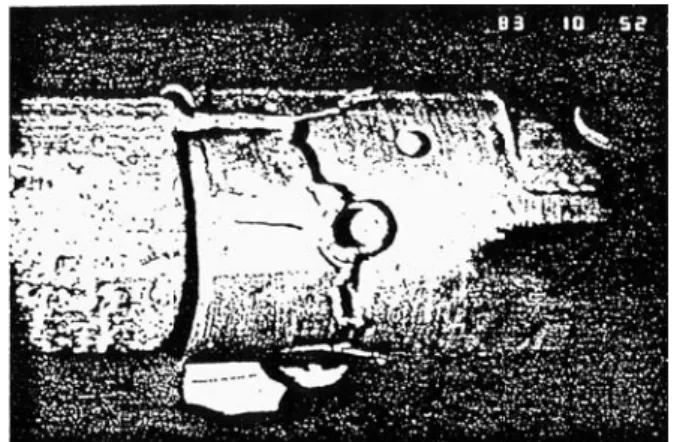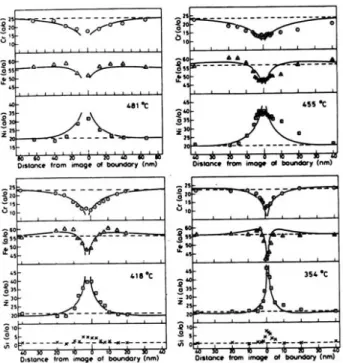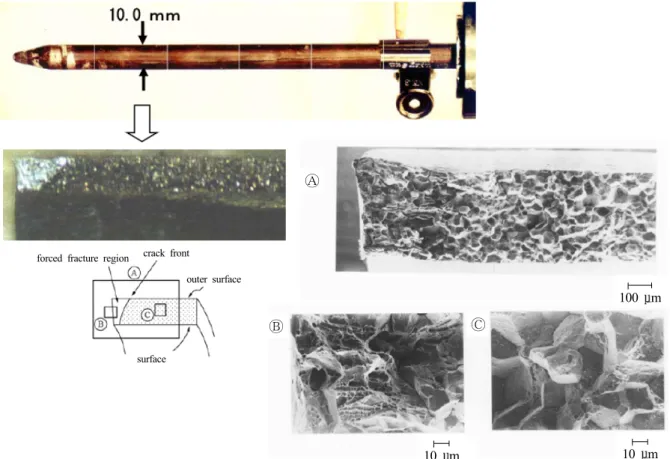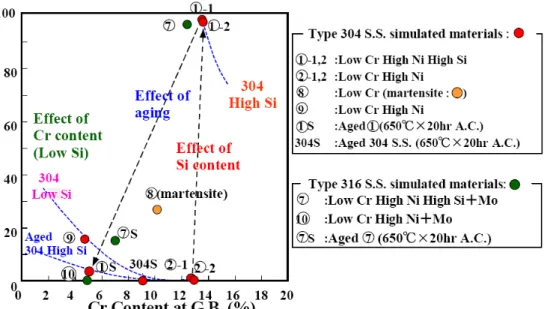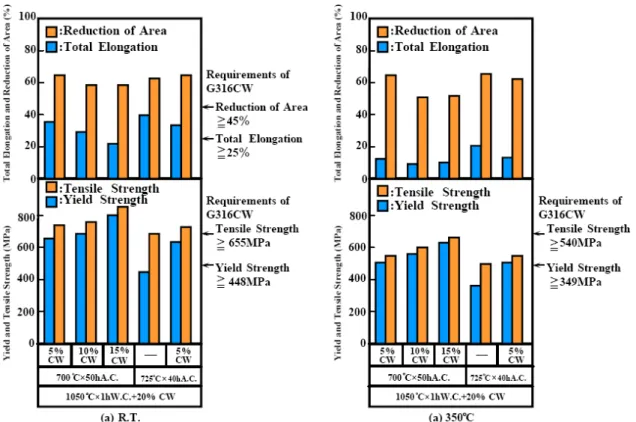Irradiation Assisted Stress Corrosion Cracking of Austenitic Stainless Steels in Water Reactors
Toshio Yonezawa
Fracture and Reliability Research Institute, Tohoku University, 6-6-01, Aoba, Aramaki, Aoba-ku, Sendai City, 980-8579, Japan
Based upon the good compatibility to neutron irradiation and high temperature water environment, austenitic stainless steels are widely used for core internal structural materials of light water reactors. But, recently, intergranular cracking was detected in the stainless steels for the core applications in some commercial PWR plants. Authors studied on the root cause of the intergranular cracking and developed the countermeasure including the alternative materials for these core applications. The intergranular cracking in these core applications are defined as an irradiation assisted mechanical cracking and irradiation assisted stress corrosion cracking.
In this paper, the root cause of the intergranular cracking and its countermeasure are summarized and discussed.
Keywords : irradiation assisted stress corrosion cracking, neutron irradiation, austenitic stainless steels, control rod, baffle former bolt, swelling
†Corresponding author: t-yonezawa@rift.mech.tohoku.ac.jp
1. Introduction
Austenitic stainless steels have been commonly used for core internal structural materials of light water reactors and heavy water reactors, due to its good compatibility to neutron irradiation and high temperature water environ- ment. However, in early 1970s, intergranular cracking (IGC) was observed in the 25%Cr-20%Ni austenitic stain- less steel of the parts of fuel assembly for steam generating heavy water reactor, as shown in Fig. 1,1) and the Cr deple- tion and Ni, Si enrichment were detected near the grain boundaries of this irradiated material, as shown in Fig.
2.1) This is well-known as the first experience of an irradi- ation assisted stress corrosion cracking (IASCC) in actual nuclear reactor. The other IGC was observed in the clad tube of the rodlets in rod cluster control assemblies (RCCA) for USA’s, Japanese, Swedish and French PWRs.2),3),4),5) This is called as the irradiation assisted me- chanical cracking (IAMC).3)
A world-wide consensus has developed that the term IASCC be applied to all instances where environmental cracking has been accelerated by irradiation, whether its acts singly or conjointly to alter water chemistry, material microchemistry, material hardness, creep behavior and so on. IASCC of austenitic stainless steel for core applica- tions has recently become an important study issue in Light
Water Reactors.6) The IASCC of the austenitic stainless steels for core applications is thought to be mainly caused by the degradation of the material properties and pro- duction of the radical oxidants.
The degradation of the material properties after irradi- ation has been reported7),8),9),10) as follows:
1) Irradiation induced grain boundary segregation of al- loying elements, such as Cr and Mo depletion and Ni, Si, S, P enrichment.
2) Phase transformation to martensite, producing voids and increasing dislocation density.
3) Increasing the yield strength and hardness, while de- creasing the ductility.
Fig. 1. Detected intergranular crack on the parts of fuel assembly for SGHWR
Fig. 2. Chemical composition near the grain Boundaries of cracked 25%Cr-20% Ni for fuel part of SGHWR
Radiation water chemistry is a complex subject which has been studied for decades. Ionizing radiation causes wa- ter to break down into a number of primary species:
H2O → e-aq, H+, H, H2, O2, OH, H2O2, HO2,… (1)
Including molecules (e.g., H2O2, H2) and radicals (e.g., e-aq, H, OH, HO2) which are both oxidizing (e.g, H+, HO2, H2O2) and reducing (e.g., e-aq, H, H2). These species inter- act via known reactions and, in a closed system containing no other solutes, their concentrations are proportional to the square root of the radiation flux. Their concentrations will also depend upon additions of, e.g., hydrogen, oxygen and ionic species.
So, IASCC susceptibility for austenitic stainless steels is depended upon the water chemistry. The IASCC sus- ceptibility rises above a fluence of about 5 x 1020 n/cm2 (E>1MeV) for BWRs, above a fluence of about 1 x 1021 n/cm2 (E>0.1MeV) for PWRs. Displacement damage (dpa) is a more fundamental and physical measure than fluence of the irradiation damage to metals; conversion between n/cm2 or dpa depends upon the neutron energy spectrum and the target material, with typical values for stainless steel in BWR’s being about 1.5 x 1021 n/cm2 per dpa for neutron energies above 0.1 MeV and about 0.7 x 1021 n/cm2 per dpa for neutron energies above 1 MeV.
In this paper, the results of the recent studies on IAMC
and IASCC for the austenitic stainless steels in PWR envi- ronment are reviewed and the future direction of studies on this matter is discussed.
2. Iamc
The tips of the rodlets in RCCA are exposed to an ex- tremely high neutron fluence in fuel assemblies. Since high neutron fluence causes degradation of the cladding tube material (Type 304 stainless steel) and swelling of the neu- tron absorber (80%Ag-15%In-5%Cd alloy), the integrity of the RCCA will be affected.
In USA. Japan, Sweden and France, some rodlets of RCCA were applied to the post irradiation examination (PIE) after 10 fuel cycles operation. In these PIEs, longi- tudinal crack was commonly observed in the cladding tubes. In case of authors’ PIE, it was identified that the intergranular crack was initiated from the inner surface (absorber side), as shown in Fig. 3.3) That is, this type intergranular crack was not affected by high temperature water. It is essential to investigate whether or not IAMC can cause IGC. The results of tensile tests on irradiated cladding tube material by Manahan and co-workers are shown in Fig. 4.2) These tests were carried out in an argon gas atmosphere and at very low strain rates. The data in Fig. 4 seem to indicate that intergranular cracks can be induced at a very low strain rate in tensile tests. Therefore, intergranular cracks of irradiated material are not always evidence of IASCC.
Author and previous co-workers analyzed the root cause of this type crack. From our analyses, we concluded as follows:
1) The effect of deformation of the absorber due to slumping caused by dynamic loads and creep is negligible.
2) The mechanism of the intergranular cracks in the cladding tube is not IASCC but IAMC caused by an increase in hoop strain due to swelling of the absorber at a very slow strain rate and decrease in elongation due to neutron irradiation.
3) The cladding tube initiation limit for PWR RCCA rodlets due to absorber swelling was investigated by considering the tube as a pressurized cylindrical shell and this agrees well with the outer diameter increases measured at site.
On the other hand, We analyzed the hydrogen content on the various location of the cracked cladding tube mate- rial by the hot melt gas stripping method using a melting temperature ranging from 2200℃ to 2400℃, to clarify the root cause of IAMC. The hydrogen content of irradi- ated type 304 stainless steel as a function of fast neutron
Ⓐ
Ⓑ Ⓒ
10 μm 10 μm
100 μm
forced fracture region crack front
outer surface
surface
Fig. 3. Appearance of cracked RCCA rodlet and SEM images of the fracture surface of the crack on the cladding tube
Percent Intergranular Fracture
Log (t, 1/sec)
Fig. 4. Effect of strain rate on percent intergranular fracture in irradiated RCCA cladding tube2)
fluence (E>1MeV) is shown in Fig. 5. The conclusion reached on the basis of the results of BWR measurements
Fluence (F) n/cm2(E>1MeV)
Hydrogen Content (H) (wt, ppm)
Fig. 5. Hydrogen content of irradiated Type 304SS as a function of fast neutron fluence
is that the hydrogen content is independent of both fast neutron fluence and flux. However, hydrogen content seems to increase rapidly above a fluence of 1021 n/cm2 as shown in Fig. 5, although the measured values are scat- tered over a wide range. Therefore, it is possible that the hydrogen content affected by neutron fluence. Then, hy- drogen content may be one of the causes of IGC in a cladding tube at very low strain rates of 10-10 to 10-11 /sec.
The following sources of hydrogen can be considered.
(1) n-p reaction with Ni.
(2) Irradiation dissociation of coolant water.
(3) Corrosion of material
(4) Hydrogen content of main coolant water.
As there is no corrosion at the surface of the cladding tube phenomena are common to both BWR and PWR, (1) or (2) seems to be main hydrogen source. The hydrogen content does not increase upon cathode electrolysis charg- ing in the case of unirradiated material with hydrogen con- tent from six to eight ppm. This explains why an irradiated cladding tube can contain much hydrogen. Because an irra- diated material has many trap site, i.e., metallurgical struc- tural defects, hydrogen is held at the trap sites as it diffuses and becomes stable, resulting in a higher hydrogen content in the cladding tubes.
As the future work, the more data on the hydrogen con- tent for the irradiated cladding materials shall be gathered.
But, the IAMC for the cladding tubes of RCCA for PWRs were practically solved according to reducing the outer diameter of the absorber at the tip or increasing the gap between the cladding tube and the absorber, and esti- mation of proper lifetime of RCCA.2),3),4)
3. Iascc
IGC was observed in some baffle former bolts (BFBs) for core internals of French PWR, Bugey 2 in 1989.11) This defect does not directly harm the safety or operat- ability of the plant, but does give a large impact to world-wide utilities and fabricators of PWR plants. In or- der to establish the countermeasure for this cracking in the BFBs for PWR plants, author and previous co-workers studied on the cause of this IGC, and developed the alter- native materials.
3.1 Clarifying the cause of IGC
The austenitic stainless steels, even though sensitized one, has no susceptibility to the intergranular stress corro- sion cracking (IGSCC) in PWR primary water, as well known. Therefore, we have firstly estimated on the possi- bilities for the cause of the IGC in BFBs from the metal- lurgical and chemical viewpoint based upon the world- wide experience of the IGC for austenitic stainless steels in commercial PWR or BWR plants. And secondary, we have evaluated the possible cause of the IGC in BFBs from the above estimated possibilities based upon the cal- culation and experimental data, authors’ previous study12) and information published by EdF.11)
We indicated that the following types of IGC in auste- nitic stainless steels could be able to be as the possible
cause of IGC in BFBs for PWR plants.13),14) That is, the possibilities for the cause of IGC in BFBs must be follow- ing two cases;
① Mechanical cracking caused by high strain for irradi- ation hardened austenitic stainless steels (Irradiation Assisted Mechanical Cracking; IAMC)
② Irradiation assisted stress corrosion cracking (IASCC) caused by degradation of material and / or environ- ment under γ-ray and neutron irradiation
As the IASCC, following four possibilities will be able to be indicated.
(a) O2 SCC: If the air before starting up of plant is remained in the bolt stagnant region which is a nar- row gap between a bolt shank or thread and a baffle plate or baffle former plate, IGSCC may be oc- curred in the austenitic stainless steels which has been sensitized due to irradiation induced segrega- tion, particularly Cr depletion along the grain boun- daries, even though in PWR plants.
(b) SCC due to condensed alkaline caused by dry and wet phenomenon (D/W SCC): Austenitic stainless steels have the susceptibility of IGSCC in high caustic and high temperature environment, and core internals are heated by gamma ray under operation of PWR, as well known. In Baffle Former region, the temperature may be raised by γ-heating beyond the saturating temperature (343℃) under PWR re- actor coolant system pressure (~157ata). Therefore, the bolt stagnant has the possibility to be week alka- line condition due to dry and wet phenomenon.
(c) Low pH SCC due to oxygen concentration cell caused by residual oxygen (O2 Low pH type SCC):
Sensitized austenitic stainless steels have the sus- ceptibility of IGSCC in acidic high temperature water. If the air before starting up of plant is re- mained in the bolt stagnant region, the BFB shank and thread region has the possibility to be low pH condition by H3BO3 condensation due to oxygen concentration cell caused by residual oxygen. This SCC seems to be caused by above-mentioned envi- ronmental change (decreasing pH).
(d) PWSCC: Austenitic stainless steels have no sus- ceptibility to IGSCC such as PWR primary water stress corrosion cracking (PWSCC) in Ni based al- loys, as well known. However, the possibility of PWSCC for the irradiated austenitic stainless steel was indicated based upon the grain boundary chem- ical composition change by radiation induced segre- gation.6) The PWSCC may be occurred in the BFBs.
In order to evaluate the cause of the IGC in BFBs, above five possibilities were evaluated by the calculation and
some out of pile tests from the metallurgical and chemical viewpoint.
3.1.1 Iamc
BFBs are mainly applied to high tensile stress by initial fastening torque and bending stress by the deformation of baffle plates. However, the initial fastening stress will be able to be relaxed by irradiation and thermal creep.
The above IAMC could not be happened under bending stress due to deformation of baffle plate. The cause of the IGC in BFBs must be IASCC.
3.1.2 Iascc
a) O2SCC: In order to grasp the corrosion potential of the material at the area of head and thread in the bolt stagnant region, the calculation on diffusion of dissolved hydrogen and oxygen using by FEM diffusion calculation model and on pH value based upon dissociation of H3BO3
at high temperature were conducted, and also data for the kinetics of surface reactions such as exchange current den- sity, Tafel’s slope, diffusion limited current density were measured.
The corrosion potential of BFBs material at the bolt stagnant region versus operating time at the start-up of PWR plant was calculated using by for thermally sensi- tized 316 stainless steel and irradiated 316 stainless steel (thimble tube) fluence of 3.7 x 1022 n/cm2 (E>0.1Mev).
From these experiments, the corrosion potential of the BFB material at the bolt stagnant region is not over the Ecr. of IGSCC. There is little possibility of SCC to BFBs, due to residual oxygen.
b) D/W SCC: From our FEM temperature distribution calculation using by γ-ray heating distribution and heat transfer coefficient of BFBs, the temperature at the surface of BFB shank area is slightly over 343℃ of boiling tem- perature, in case of 120% of γ-ray heating for a 3 loop PWR plant, but is under 343℃ in case of best fit γ-ray heating for 2, 3 and 4 loop PWR plants. From our SCC tests under condensed alkaline caused by dry and wet phe- nomenon using by the model BFBs made of unirradiated 316 CW stainless steel, loaded actual stress and added with crevice devised under heat transfer condition at 331 to 332℃ in simulated PWR primary water, IGSCC was ob- served at the shank area of the model BFBs, after 2,000 hours test. From this result, if SCC due to condensed alka- line caused by dry and wet phenomenon will be able to occur in the actual BFBs, IGSCC will occur after the short time operation. It is concluded that there is no possibility of this type SCC in actual BFBs.
c) O2 Low pH type SCC: From our analysis by Nernst- Planck’s formula and producing of analytical program about the migration of ion under electro-chemical potential
gradient by the experiment of pH changing behavior, and the calculation about diffusion coefficient of H3BO3 at high temperature from the electric conductivity, based upon the correlation between the diffusion coefficient of ion and electric conductivity, the water chemistry of bolt stagnant region is decreasing of pH revealed due to the difference of oxygen concentration, but the pH in bolt stag- nant region is within neutral, even though lowest pH (about 3) of IGSCC for sensitized 304 stainless steel. It is concluded that there is no possibility of low pH SCC due to oxygen concentration cell caused by residual oxygen.
d) PWSCC: From our accelerated SCC tests by slow strain rate tensile (SSRT) tests in simulated PWR primary water using by the irradiated materials, the effect of test temperature on the threshold fluence for IGSCC is remark- able and the threshold neutron fluence has the tendency to become lower with an increase of test temperature.
This tendency looks-like the PWSCC susceptibility of Ni based alloys in simulated PWR primary water. It is concluded that the IGC of the highly irradiated austenitic stainless steel such as BFBs is PWSCC due to RIS.
3.2 Developing of alternative materials
In order to develop the irradiation assisted stress corro- sion cracking resistant austenitic stainless steels that are resistant to stress corrosion cracking under irradiation in PWR, the author and previous co-workers investigated the optimized chemical compositions and heat treatment con- ditions of 316 CW and high-Cr austenitic stainless steels for PWR baffle former bolts using SSRT tests in simulated PWR primary water for simulated austenitic stainless steels whose chemical compositions are simulated to the grain boundary chemical composition of 316 stainless steel after irradiation of 2 x 1022 n/cm2 (E>0.1Me).15),16),17),18)
Fig. 6 shows the summary of this study. The IGSCC fraction area on the fractured surface of the simulated ma- terials to the grain boundaries of the irradiated 304 and 316 stainless steels (Steels No.1 and No.7, respectively) related 98 and 95 %, respectively. Those of the high phos- phorus and Si content materials revealed less than 5 %.
The PWSCC susceptibility was very low in aged Steels No.1 and No.7 which has the coherent M23C6 carbides with matrices at the grain boundaries, in spite of the fact the PWSCC susceptibility of solution heat treated Steels No.1 and No.7 being high.
Figs. 7 and 8 summarize the PWSCC susceptibility eval- uation results for the solution heat treated specimens over Cr concentration-Ni concentration coordinate, and for the solution heat treated and aged specimens over Cr concen- tration-Ni concentration coordinate, respectively.
Fig. 6. The relationship between fluence and intergranular area fraction by SSRT tests after irradiation for austenitic stainless steels
Fig. 7. The correlation between Cr content and Ni content for solution annealed alloys
From these Fig.s, PWSCC susceptibility range for the high Si specimens (3 % Si) was defined to be lower Cr (<15%) and high Ni (10-20%) regime (shaded area) and PWSCC susceptibility for the high Ni specimens was high- er than that for the low Ni specimens. That is, the threshold Cr level yielding discernible PWSCC susceptibility tend to rise with increasing Ni concentration. For aged materi- als, that range will be shrank, comparing with the solution heat treated materials.
As the optimized chemical composition of 316 CW stainless steel, ultra-low-impurities and high-Cr content have been recommended within the requirements of the ASTM A193 B8M, as shown in Fig. 9. About 20% cold
Fig. 8. The correlation between Cr content and Ni content for solution annealed and aged alloys
working before aging and after solution treatment has also been recommended for this steel to make the grain boun- dary precipitation of coherent M23C6 carbides with matrix and recover the grain boundary Cr depletion. Heating at 700 to 725°C for 20 to 50 hours was selected as a suitable aging condition. Cold working of 5 to 10% for this steel after aging was selected to meet the requirements of me- chanical properties for PWR BFBs.
As the optimized chemical composition of the high-Cr austenitic stainless steel, ultra-low-impurities, 30% Cr, and 30% Ni contents have been recommended to bring about an increase of the PWSCC resistance and bring the thermal expansion coefficient of this material close to that of a
Table 1. Physical properties of IASCC resistant alternative stainless steel
Materials
Coefficient of Elasticity (102kg/mm2)
Density (kg/m2)
Electrical Resistivity (10-RΩ.m)
Specific Heat (J/kg. ℃)
Thermal Conductivity (W/m. ℃)
Coefficient of Expansion
(10-6/℃) Poisson's Ratio
100 ℃ 500 ℃ RT~350℃
CORELOY S1 175 7970 80 466 15.5 18.1 15.60 0.31
G316CW 199 7980 78 473 16.1 21.4 17.47 0.31
Fig. 9. The effect of the final cold working ratio on the tensile properties of modified 316 CW stainless steel at R.T. and 350℃. The thermo-mechanical process was conducted in the following order: cold working, aging, and final cold working
304 stainless steel for baffle plates, as shown in Table 1. For bolting material, thermal expansion coefficient is most important. Also, heating at 700 to 725°C for longer than 40 hours was selected as the suitable aging condition.
Cold working of 10 to 15% after aging is recommendable to meet the requirements of the mechanical properties for PWR BFBs.
4. Summary
Based upon the good compatibility to neutron irradiation and high temperature water environment, austenitic stain- less steels are widely used for core internal structural mate- rials of light water reactors. But, recently, IGC was de- tected in the stainless steels for the core applications in
some commercial PWR plants. Authors studied on the root cause of the IGC and developed the countermeasure in- cluding the alternative materials for these core applica- tions.
For IGC of the cladding tubes for RCCA, the root cause of the IGC was identified as IAMC, and the reducing of the diameter for absorber and proper evaluation of the life- time was applied as the countermeasure.
For IGC of BFBs, the PWSCC of the bolting materials due to the irradiation induced segregation was concluded to be root cause, so called IASCC, and alternative materi- als were developed.
Acknowledgments
The studies described in this paper were performed in Mitsubishi Heavy Industries, Ltd., when author was on the register. Author is gratefully acknowledged to previous co-workers and sponsors.
References
1. P. M. Scott, W. Foot, L. A. Goldsmith, S. Dumbill, T. M. Williams, J. M. Perks, C. A. English, and W.
G. Burns, NEA/UNIPEDE Specialists Mtg. on Life- Limiting & Regulatory Aspects of Core Internals and Pressure Vessels, Stockholm (1987).
2. M. P. Monahan, R. Kohli, J. Santucci, P. Sipush, R.
L. Harris, Trans. of 9th SMiRTC, p.75 (1987).
3. T. Matsuoka, T. Yonezawa, K. Nakamura, K. Murakami, J. Shimizu, and T. Nagata, J. of Nuclear Science and Technology, 35, 564 (1998).
4. J. E. Moon, H. W. Keller, D. J. Colburn, Proceedings of the International Conference on Fontevraud III, p.726 (1994).
5. C. Janssen, Unpublished Paper (2002).
6. K. Fujimoto, T. Yonezawa, E. Wachi, Y. Yamaguchi, M. Nakano, R. P. Shogan, J. P. Massoud, and T. R.
Mager, Proceedings of the 12th International Conference on Environmental Degradation of Materials in Nuclear Power Systems-Water Reactors-, p.299 (2005).
7. P. L. Andresen, F. P. Ford, S. M. Murphy, and J. M.
Perks, Proceedings of the 4th International Symposium on Environmental Degradation of Materials in Nuclear Power Systems-Water Reactor-, p.1, NACE, Jekyll Island (1990).
8. P. Scott; J. Nuclear Materials, 211, 101 (1994).
9. A. J. Jacobs, Letter Report and Literature Search, GE
Nuclear Energy, San Jose, (1979).
10. M. Kodama, S. Nishimura, J. Morisawa, S. Suzuki, S.
Shima, and M. Yamamoto, Proceedings of the 5th International Symposium on Environmental Degradation of Materials in Nuclear Power Systems-Water Reactors-, p.948, Monterey (1991).
11. R. Cauvin, O. Goltrant, Y. Rouillon, E. Verzaux, A.
Cazus, P. Dubuisson, P. Poitrenaud, S. Bellet, Proceed- ings of the International Conference on Fontevraud III, p.54, (1994).
12. T. Yonezawa, K. Fujimoto, H. Kanasaki, T. Iwamura, S. Nakada, K. Ajiki, K. Sasaki, Proceedings of the International 8th International Symposium on Environ- mental Degradation of Materials in Nuclear Power Systems-Water Reactors-, p.823, (1997).
13. T. Yonezawa, K. Arioka, H. Kanasaki, E. Otsuka, S.
Urata, H. Mizuta, Proceedings of the International Conference on Fontevraud IV, p.237, (1998).
14. T. Yonezawa, T. Iwamura, K. Fujimoto, K. Ajiki, Proceedings of the Ninth International Symposium on
“Environmental Degradation of Materials in Nuclear Power Systems-Water Reactors”, p.1015, Newport Beach (1999).
15. K. Fujimoto, T. Yonezawa, T. Iwamura, K. Ajiki, S.
Urata, Corrosion Engineering, 49, 701 (2000).
16. T. Yonezawa, K. Fujimoto, H. Kanasaki, T. Iwamura, S. Nakada, K. Ajiki, S. Urata, Corrosion Engineering, 49, 655 (2000).
17. T. Yonezawa, K. Fujimoto, T. Iwamura, S. Nishida, ASTM STP 1401, 224 (2000).
18. J. Conermann, R. P. Shogan, K. Fujimoto, T. Yonezawa, Y. Yamaguchi, Proceedings of the Twelfth International Conference on “Environmental Degradation of Materials in Nuclear Power Systems-Water Reactors”, p.277, Salt Lake (2005).
